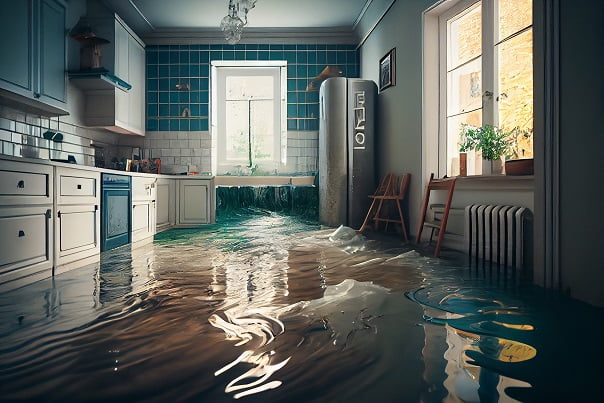When you find your bathroom flooded, panic sets in as you wonder, “Why is my bathroom flooding?” The reasons can be diverse, ranging from simple issues like blocked drainage systems to more complex problems such as structural damage and improper installations. In this comprehensive guide, we will delve into each potential cause, offering insights and solutions to help you address and prevent bathroom flooding effectively.
Blocked Drainage Systems: Understanding the Root Cause
Bathroom flooding often begins with blocked drainage systems, disrupting the smooth flow of water. Accumulated hair, soap scum, and other debris gradually clog pipes, causing water to back up. To identify the root cause, start by inspecting the sink and shower drains for visible blockages. If the issue persists, a deeper blockage may be present in the main drainage line.
To remedy this, consider using a plunger or a drain snake to remove obstructions. For persistent blockages, professional plumbing services may be necessary to inspect and clear the drainage system thoroughly. Regular maintenance, such as using drain screens and periodically flushing drains with hot water, can prevent future blockages, ensuring a consistently efficient drainage system.
Plumbing Malfunctions: Diagnosing Common Issues
Plumbing malfunctions are a common culprit behind bathroom flooding, often stemming from issues with pipes, joints, or fixtures. Leaks can develop over time, causing water to seep into walls, floors, and ceilings. To diagnose these problems, check for visible signs of water damage, such as discolored walls, bubbling paint, or damp areas.
Addressing plumbing malfunctions requires a systematic approach. Begin by inspecting all visible pipes for leaks, corrosion, or damage. Tightening loose joints and replacing faulty pipes can resolve minor issues, but for more complex problems, seeking professional help is crucial. Regular inspections, especially in older homes, can help detect and rectify plumbing malfunctions early on, preventing extensive water damage and potential flooding.
Overflows and Leaks: Identifying Problematic Areas
Toilets, sinks, and bathtubs are susceptible to overflows and leaks, contributing to bathroom flooding. Faulty flappers, worn-out seals, or loose connections can lead to water escaping where it shouldn’t. Identifying problematic areas early on is crucial to prevent water damage.
Inspecting toilet tanks and ensuring the proper functioning of the flapper valve is essential. Leaks around sinks and tubs can often be traced to damaged seals or loose connections. Regularly checking and replacing worn-out parts can help maintain the integrity of these fixtures, preventing leaks and overflows that may lead to bathroom flooding. In the event of continuous issues, consulting a plumber can provide a thorough assessment and lasting solutions.
Faulty Fixtures: Evaluating the Integrity of Bathroom Components
Faulty fixtures, such as faucets, showerheads, and bathtub spouts, can contribute significantly to bathroom flooding. Over time, these fixtures can wear out, leading to leaks and water wastage. Regularly assessing the integrity of bathroom components is vital in preventing potential flooding incidents.
Examine faucets for drips and leaks, replacing worn-out washers or damaged parts promptly. Showerheads should be checked for proper attachment and any signs of leakage. Bathtub spouts should divert water efficiently without any seepage. Timely repairs or replacements of faulty fixtures can safeguard against water damage and potential flooding, ensuring the smooth operation of your bathroom’s water systems.
Structural Damage: Assessing the Impact on Water Flow
Structural damage within your home can contribute to bathroom flooding. Cracks in walls, ceilings, or floors can allow water to infiltrate, leading to extensive damage over time. Identifying and addressing structural issues is crucial to maintaining the integrity of your home’s water containment.
Inspect your bathroom and surrounding areas for any visible signs of structural damage, such as cracks, gaps, or water stains. These issues may require professional intervention to assess the severity and provide suitable repairs. Regular home maintenance, including sealing cracks and addressing any structural vulnerabilities, can mitigate the risk of water infiltration and potential flooding.
Weather-Related Factors: Considering External Influences
Weather-related factors, such as heavy rainfall or storms, can contribute to bathroom flooding. Excessive water accumulation around your home can infiltrate foundations, basements, or ground-level bathrooms. Understanding how weather affects your home’s water drainage is crucial in preparing for and preventing potential flooding.
Ensure your home has proper drainage systems, including gutters and downspouts, to direct rainwater away from the foundation. Installing sump pumps in basements or vulnerable areas can help manage excess water during heavy rainfall. Regularly check for any signs of water seepage during or after storms, addressing any issues promptly to prevent long-term damage.
Poor Maintenance Practices: Addressing Neglected Areas
Neglected maintenance practices can contribute to bathroom flooding over time. Ignoring routine inspections, neglecting repairs, and overlooking potential issues can result in water damage that may lead to more significant problems. Adopting proactive maintenance practices is essential in preserving the functionality of your bathroom.
Regularly inspect all bathroom components, including pipes, fixtures, and drainage systems, for signs of wear or damage. Promptly address any leaks or malfunctions to prevent water from spreading. Implement a maintenance schedule that includes cleaning drains, checking for leaks, and inspecting fixtures. Consistent upkeep can significantly reduce the risk of bathroom flooding caused by poor maintenance practices.
Aging Infrastructure: Recognizing Signs of Deterioration
Aging infrastructure is a common factor contributing to bathroom flooding. Over time, pipes, seals, and other components can deteriorate, leading to leaks and water damage. Recognizing the signs of aging infrastructure is crucial in implementing timely repairs or replacements.
Regularly inspect the condition of pipes, especially in older homes, for signs of corrosion, rust, or degradation. Check seals around fixtures and joints for wear and tear. Upgrading plumbing systems in older homes can prevent catastrophic failures and potential flooding. Proactive measures, such as replacing aging pipes and fixtures, can extend the lifespan of your bathroom’s infrastructure and minimize the risk of flooding.
Improper Installation: Examining Workmanship and Errors
Improper installation during the construction or renovation of your bathroom can contribute to water-related issues and flooding. Incorrectly sealed joints, poorly connected pipes, or faulty installations may lead to leaks and water damage over time. Examining the workmanship and addressing installation errors is crucial for preventing future problems.
Carefully inspect all plumbing installations, ensuring joints are properly sealed, pipes are securely connected, and fixtures are correctly fitted. Professional installation services can rectify any errors and ensure that your bathroom is built to withstand water pressure and usage. Thoroughly examining the quality of installation during construction or renovation can prevent potential flooding and ensure the longevity of your bathroom.
Water Pressure Problems: Exploring Variations and Solutions
Water pressure problems can be a contributing factor to bathroom flooding. Excessive water pressure can strain pipes, fixtures, and connections, leading to leaks and potential flooding. Understanding water pressure variations and implementing suitable solutions is essential for maintaining a well-functioning plumbing system.
Install pressure-regulating devices to control water pressure within the recommended range. Regularly monitor water pressure levels and address any sudden spikes promptly. Consulting with a plumber can help assess the water pressure in your home and recommend appropriate adjustments or installations. Managing water pressure effectively can prevent the strain on your plumbing system, minimizing the risk of leaks and potential flooding.
FAQs – Why Is My Bathroom Flooding?
Certainly! Here are some frequently asked questions (FAQs) along with concise answers related to the topic “Why Is My Bathroom Flooding?”
Q: Why is my bathroom flooding?
A: Various factors such as blocked drains, plumbing issues, or structural damage can contribute to bathroom flooding.
Q: How can I identify a blocked drainage system?
A: Look for slow drainage, gurgling sounds, or water backing up. Professional inspection may be needed for deeper issues.
Q: What are common plumbing malfunctions causing flooding?
A: Leaks, pipe damage, and joint issues are common. Regular inspection and prompt repairs are essential.
Q: How can I prevent toilet overflows and leaks?
A: Regularly check flappers, seals, and connections. Timely repairs and replacements can prevent water escape.
Q: What fixtures are prone to faults leading to flooding?
A: Faucets, showerheads, and bathtub spouts. Regular maintenance and timely replacements are crucial.
Q: How does structural damage contribute to bathroom flooding?
A: Cracks in walls or floors allow water infiltration. Prompt repairs are essential to prevent extensive damage.
Final Words:
In conclusion, understanding the diverse factors that contribute to bathroom flooding is crucial for effective prevention and maintenance. Whether dealing with blocked drainage systems, plumbing malfunctions, or external influences like weather-related factors, a proactive approach to inspection and maintenance can safeguard your home from water damage. By identifying potential issues early on and implementing timely solutions, you can ensure a functional and flood-free bathroom for years to come. Remember, regular attention to maintenance is the key to a dry and secure bathroom environment.
Divine Wordsmith is a spiritual guide and writer, weaving tales of wisdom and insight to inspire inner growth and connection to the divine. Join the journey of self-discovery and enlightenment through the transformative power of words.




